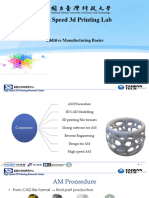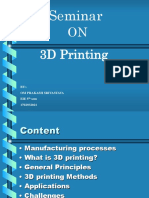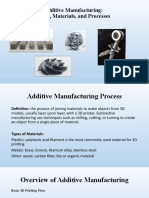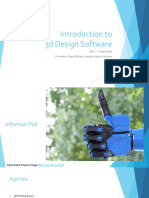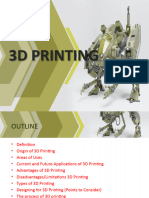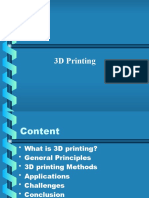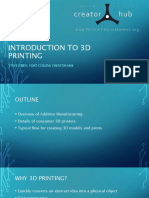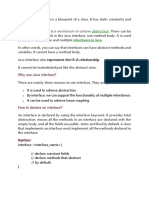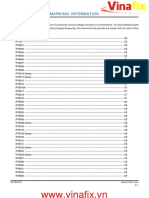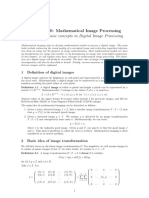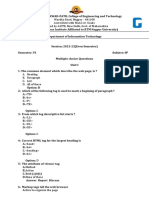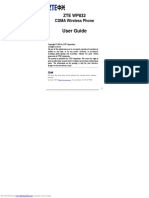|| 3D Printing and Design (Basics) ||
ManufacturingIntroduction
Unit-1.0 Additive Manufacturing Introductionand
andCAD
CAD
1.1 CAD-CAM and its Integration
● CAD (Computer-Aided Design): CAD software allows engineers and designers to create
3D models of objects on a computer. These models can be manipulated, analyzed, and
modified before any physical prototypes are made.
● CAM (Computer-Aided Manufacturing): CAM software translates the 3D CAD model
into instructions for manufacturing equipment, such as CNC machines or 3D printers. It
optimizes the manufacturing process by considering factors like toolpaths, speeds, and
feeds.
● Integration: CAD-CAM integration streamlines the manufacturing process by eliminating
the need for manual data entry and reducing errors. It allows for seamless transfer of
design data from the design phase to the manufacturing phase, improving efficiency and
accuracy.
1.2 CAD- Part and Surface Modeling
● Part Modeling: This involves creating solid 3D models of objects by combining basic
geometric shapes (like cubes, cylinders, and spheres) or using Boolean operations
(union, intersection, subtraction).
● Surface Modeling: This focuses on creating complex, free-form surfaces, often used for
objects with intricate curves and shapes, such as car bodies or jewelry.
1.3 CAD File Formats
CAD models are typically saved in specific file formats. Common formats include:
● STL (STereoLithography): A widely used format for 3D printing, representing the model
as a mesh of triangular facets.
● STEP (Standard for the Exchange of Product model data): A complex format for
exchanging product data between different CAD systems.
● IGES (Initial Graphics Exchange Specification): Another format for exchanging product
data, commonly used in the aerospace and automotive industries.
1.4 Additive v/s Conventional Manufacturing Processes
● Additive Manufacturing (AM): Builds objects layer by layer, adding material to create the
final product. Examples include 3D printing, powder bed fusion, and directed energy
deposition.
● Conventional Manufacturing: Involves removing material from a larger block to create
the desired shape. Examples include milling, turning, and drilling.
1.5 Process Chain for 3D Printing
1. Design: Creating the 3D model using CAD software.
2. Slicing: The 3D model is sliced into thin layers, generating toolpaths for the 3D printer.
3. Printing: The 3D printer builds the object layer by layer, following the generated
toolpaths.
4. Post-Processing: Removing support structures, cleaning, and finishing the printed part.
1.6 Classification of 3D Printing Processes
3D printing processes can be classified based on the material used and the method of
deposition:
● Material Jetting: Deposits a liquid or powdered material layer by layer, which then
solidifies.
● Binder Jetting: Binds powdered material together using a liquid binder.
● Powder Bed Fusion: Uses a laser or electron beam to fuse powdered material together.
● Directed Energy Deposition: Deposits molten material layer by layer using a laser or
electron beam.
� ● Sheet Lamination: Cuts and stacks thin layers of material to build the object.
1.7 Product Design and Prototyping
● Product Design: 3D printing enables the creation of complex and customized designs
that would be difficult or impossible to manufacture using conventional methods.
● Prototyping: 3D printing allows for rapid prototyping, enabling designers to quickly create
physical models of their designs for testing and evaluation.
1.8 Reverse Engineering for 3D Printing
Reverse engineering involves creating a 3D model of an existing object by scanning it using
techniques like laser scanning or computed tomography (CT). This 3D model can then be used
for 3D printing to create replicas or modified versions of the original object.
�Certainly, let's delve into the intricacies of Data Preparation for 3D Printing, covering all the
aspects you've mentioned.
Preparationfor
Unit-2.0 Data Preparation for3D
3DPrinting
Printing
Data preparation is a crucial step in the 3D printing process, ensuring the success of the final
product. It involves converting a 3D model into a format that the 3D printer can understand and
process.
1. STL Interface Specification & STL Data Generation
● STL (STereoLithography) is a widely used file format for representing 3D models in 3D
printing.
● It describes the surface geometry of an object as a collection of triangular facets.
● Each facet is defined by three vertices and their outward-facing normal vector.
● STL data generation typically occurs through:
○ CAD software: Most CAD programs (like SolidWorks, Autodesk Inventor, Fusion
360) can export models in STL format.
○ 3D scanning: Scanning physical objects creates point cloud data, which can be
processed into an STL model.
○ 3D modeling software: Programs like Blender, Maya, and ZBrush allow for the
creation and export of 3D models in STL format.
2. STL Data Manipulation
● Simplification: Reducing the number of triangles can decrease file size and improve
printing speed, but may compromise accuracy.
● Repair: Fixing errors in the STL data, such as non-manifold geometry, holes, or
intersecting surfaces, is crucial for successful printing.
● Scaling and Transformation: Adjusting the size, position, and orientation of the model.
3. Advantages and Limitations of STL File Format
● Advantages:
○ Simple and widely supported format.
○ Easy to understand and implement.
○ Can represent complex geometries.
● Limitations:
○ Can be large file sizes for complex models.
○ Low precision for representing curved surfaces.
○ Does not contain color or material information.
4. Open Files & Repair of STL Files
● Open files: Software tools like Meshmixer, Netfabb, and 3D Builder can be used to open
and inspect STL files.
● Repair of STL files: These tools can identify and repair common STL errors such as:
○ Non-manifold geometry: Issues where surfaces intersect incorrectly.
○ Holes and gaps: Missing faces or incomplete boundaries.
○ Intersecting surfaces: Overlapping parts of the model.
5. Alternative 3D Printing Interfaces
● AMF (Additive Manufacturing File Format): A newer format that provides more
information than STL, including color, materials, and support structures.
● OBJ (Object File Format): A general 3D graphics format that can be used for 3D
printing, but may require additional processing.
● 3MF (3D Manufacturing Format): An open standard for 3D printing that aims to improve
interoperability and data exchange.
6. Part Orientation and Support Generation
� ● Part orientation: The positioning of the model on the print bed significantly impacts print
quality, build time, and material usage.
● Factors affecting part orientation:
○ Surface area: Minimizing the surface area in contact with the build plate can
reduce warping and improve adhesion.
○ Overhangs: Parts with significant overhangs require support structures to prevent
sagging and deformation.
○ Internal cavities: Orientation should allow for proper infill and drainage of support
material.
● Models for part orientation determination:
○ Brute-force algorithms: Evaluate a large number of orientations.
○ Heuristic algorithms: Use rules and guidelines to quickly identify good
orientations.
○ Genetic algorithms: Utilize evolutionary principles to find optimal orientations.
● The function of part supports:
○ Prevent sagging and deformation: Support overhanging features.
○ Ensure proper infill: Support internal cavities and hollow sections.
○ Enable bridging: Allow for the creation of gaps or unsupported spans.
● Support structure design:
○ Density: The amount of support material used, balancing strength and ease of
removal.
○ Geometry: The shape and arrangement of support structures, minimizing contact
area with the printed part.
● Automatic support structure generation: Most modern slicing software includes
automated support generation algorithms.
7. Model Slicing and Contour Data Organization
● Slicing: The process of dividing the 3D model into a series of 2D cross-sections (layers).
● Contour data organization: The sliced data is organized into a series of contours,
representing the outer boundaries and internal holes of each layer.
8. Direct and Adaptive Slicing
● Direct slicing: Creates layers with a constant thickness.
● Adaptive slicing: Adjusts layer thickness based on the model's geometry and features.
○ Identification of peak features: Detects sharp corners, edges, and other critical
features.
○ Adaptive layer thickness determination:
■ Thinner layers are used in areas with high curvature or complex features.
■ Thicker layers are used in areas with simpler geometry.
9. Tool Path Generation
● Tool path generation: The process of determining the precise movements of the 3D
printer's nozzle to deposit material according to the sliced data.
● Factors considered:
○ Infill patterns: How the internal structure of the part is filled (e.g., grid, honeycomb,
gyroid).
○ Wall thickness: The number of layers used to create the outer walls of the part.
○ Nozzle speed and temperature: Optimized for the specific material and printing
process.
I hope this comprehensive explanation provides a solid foundation for understanding Data
3DPrinting.
Preparation for 3D Printing. Feel free to ask if you have any further questions!
� AdditiveManufacturing
Unit 3.0: Additive ManufacturingTechniques
Techniques
Additive Manufacturing (AM), also known as 3D printing, has revolutionized the way we design
and manufacture objects. It involves building a three-dimensional object layer by layer, adding
material in a controlled manner. This approach offers significant advantages over traditional
subtractive manufacturing methods, such as CNC machining, where material is removed to
achieve the desired shape.
Here are some of the most common AM techniques:
1. Stereolithography (SLA)
● Process:
○ A vat of liquid photopolymer resin is used.
○ A UV laser selectively cures the resin layer by layer, solidifying the desired shape.
○ The build platform is lowered after each layer is cured, and a new layer of resin is
applied.
○ Once the object is complete, it is removed from the vat and post-processed to
remove excess resin and improve surface finish.
● Advantages:
○ High accuracy and resolution
○ Good surface finish
○ Wide range of materials available
● Disadvantages:
○ Relatively slow process
○ Can be expensive due to the cost of materials and equipment
○ Requires post-processing to remove support structures
2. Selective Laser Sintering (SLS)
● Process:
○ A bed of powdered material (e.g., plastic, metal) is used.
○ A laser selectively sinters (melts and fuses) the powder particles, creating the
desired shape.
○ A new layer of powder is applied on top, and the process is repeated until the object
is complete.
○ Excess powder is reused.
● Advantages:
○ Can produce complex geometries
○ Can use a wide range of materials
○ Relatively fast process
● Disadvantages:
○ Powder handling can be messy
○ Surface finish may not be as smooth as SLA
○ Post-processing is required to remove excess powder
3. Fused Deposition Modeling (FDM)
● Process:
○ A thermoplastic filament is fed through a heated nozzle.
○ The melted filament is extruded layer by layer, creating the desired shape.
○ The build platform moves in a controlled manner to create the object.
● Advantages:
○ Relatively inexpensive and accessible
○ Wide range of materials available
○ Simple to operate
� ● Disadvantages:
○ Lower resolution and accuracy compared to SLA and SLS
○ Can have visible layer lines
○ Limited material properties compared to some other methods
4. Binder Jetting
● Process:
○ A bed of powder material is used.
○ A binder (e.g., liquid adhesive) is selectively jetted onto the powder, binding the
particles together to form the desired shape.
○ A new layer of powder is applied, and the process is repeated.
● Advantages:
○ Can produce large, complex objects
○ Can use a wide range of materials
○ Relatively fast process
● Disadvantages:
○ Can have lower strength compared to some other methods
○ Post-processing is required to remove excess powder and improve strength
5. Direct Metal Laser Sintering (DMLS)
● Process:
○ Similar to SLS, but uses metal powders instead of plastics or ceramics.
○ A high-powered laser melts and fuses metal particles together, creating the desired
shape.
● Advantages:
○ Can produce high-strength metal parts
○ Can create complex geometries
○ Ideal for functional prototypes and end-use parts
● Disadvantages:
○ Expensive equipment and materials
○ Requires specialized expertise
6. Direct Energy Deposition (DED)
● Process:
○ A focused energy source (e.g., laser, electron beam) is used to melt and deposit
metal powder or wire onto a substrate.
○ The process can be used for both additive and subtractive manufacturing.
● Advantages:
○ Can repair or reinforce existing parts
○ Can create large, complex structures
○ Can use a wide range of materials
● Disadvantages:
○ Requires specialized equipment and expertise
○ Can be a complex process to master
Process Parameters
The specific parameters used in each AM process can significantly affect the quality and
properties of the final product. These parameters include:
● Layer thickness: The thickness of each layer of material.
● Infill density: The amount of material used to fill the interior of the object.
● Temperature: The temperature of the nozzle, build chamber, or laser.
● Speed: The speed at which the nozzle or laser moves.
� ● Power: The power of the laser or other energy source.
Process Selection for Various Applications
The choice of AM process depends on various factors, such as:
● Material requirements: The desired mechanical properties, chemical resistance, and
other material properties.
● Geometric complexity: The complexity of the object's shape and features.
● Accuracy and resolution: The required level of precision and detail.
● Production volume: The number of parts to be produced.
● Cost: The overall cost of the process, including equipment, materials, and labor.
3D Printing Materials and Selection
A wide range of materials can be used in AM, including:
● Plastics: PLA, ABS, nylon, polycarbonate, etc.
● Metals: Aluminum, steel, titanium, etc.
● Ceramics: Alumina, zirconia, etc.
● Composites: Carbon fiber reinforced polymers, etc.
The choice of material depends on the specific application and the desired properties of the final
product.
Comparison between FDM, SLS, and SLA
Feature FDM SLS SLA
Process Material extrusion Powder bed fusion Vat
photopolymerization
Materials Thermoplastics Plastics, metals, Photopolymers
ceramics
Accuracy Moderate High High
Surface finish Can have visible layer Can be rough Smooth
lines
Build speed Relatively fast Moderate Can be slow
Cost Relatively inexpensive Moderate Can be expensive
Complexity Moderate High High
In conclusion, AM is a versatile and rapidly evolving technology with a wide range of
applications across various industries. By understanding the different processes and their
respective advantages and disadvantages, engineers and designers can select the most
appropriate AM technique for their specific needs.
�Unit-4.0 Application of of3D
3DPrinting
Printing
4.1 Additive Manufacturing Applications
Additive Manufacturing (AM), commonly known as 3D printing, has revolutionized various
industries by offering unprecedented design freedom and production flexibility. Here's a detailed
look at its applications across key domains:
1. Aerospace:
● Lightweight Components: 3D printing enables the creation of complex, lightweight
components with intricate internal structures, reducing aircraft weight and improving fuel
efficiency. Examples include engine parts, aircraft interiors, and structural components.
● Rapid Prototyping: 3D printing facilitates rapid prototyping of aerospace components,
accelerating the design and development process.
● On-Demand Manufacturing: 3D printing can be used for on-demand manufacturing of
spare parts and tools, reducing lead times and minimizing downtime.
● Space Exploration: 3D printing is crucial for space exploration, enabling the production
of tools, spare parts, and even structures on-site, reducing the need for extensive
ground-based manufacturing and logistics.
2. Electronics:
● Complex Geometries: 3D printing allows for the creation of complex electronic
components with intricate geometries, such as antennas, heat sinks, and embedded
electronics.
● Functional Prototyping: 3D printing enables functional prototyping of electronic devices,
accelerating the design and testing process.
● Personalized Electronics: 3D printing can be used to create customized electronic
devices, such as hearing aids and wearable technology.
● Microelectronics: 3D printing is being explored for the production of microelectronic
components, enabling the creation of smaller, more efficient devices.
3. Healthcare:
● Personalized Medicine: 3D printing enables the creation of personalized medical
devices, such as prosthetics, implants, and surgical guides.
● Surgical Planning: 3D printing allows surgeons to create 3D models of patient anatomy,
aiding in surgical planning and reducing surgical risks.
● Drug Delivery: 3D printing is used to create customized drug delivery systems, such as
personalized pills and implants.
● Tissue Engineering: 3D printing is being explored for tissue engineering, enabling the
creation of artificial tissues and organs.
4. Defense:
● Rapid Prototyping: 3D printing enables rapid prototyping of military equipment, such as
weapons, armor, and vehicles.
● On-Demand Manufacturing: 3D printing can be used for on-demand manufacturing of
spare parts and tools for military operations.
● Lightweight Structures: 3D printing allows for the creation of lightweight, durable
structures for military applications, such as shelters and bridges.
● Personalized Equipment: 3D printing can be used to create customized military
equipment, such as protective gear and prosthetics.
5. Automotive:
● Lightweight Components: 3D printing enables the creation of lightweight automotive
components, such as engine parts, suspension systems, and body panels.
● Rapid Prototyping: 3D printing facilitates rapid prototyping of automotive components,
� accelerating the design and development process.
● Customized Vehicles: 3D printing can be used to create customized vehicles, such as
concept cars and personalized accessories.
● Tooling and Fixtures: 3D printing is used to create custom tooling and fixtures for
automotive manufacturing.
6. Construction:
● Complex Structures: 3D printing enables the construction of complex structures, such
as architectural models, custom building components, and even entire buildings.
● Rapid Construction: 3D printing can be used for rapid construction of temporary
structures, such as shelters and bridges.
● Sustainable Construction: 3D printing can be used to create sustainable building
materials, such as concrete and composite materials.
7. Food Processing:
● Customized Food: 3D printing enables the creation of customized food products, such
as personalized chocolates, candies, and personalized nutrition bars.
● Food Packaging: 3D printing can be used to create custom food packaging, such as
personalized containers and edible packaging.
● Food Production: 3D printing is being explored for the production of food products, such
as meat substitutes and personalized nutrition supplements.
8. Machine Tools:
● Custom Tooling: 3D printing enables the creation of custom tooling and fixtures for
machine tools, such as jigs, fixtures, and molds.
● Rapid Tooling: 3D printing facilitates rapid tooling for machine tools, reducing lead times
and improving productivity.
● Tool Repair: 3D printing can be used to repair damaged machine tool components,
reducing downtime and maintenance costs.
Conclusion:
3D printing has emerged as a transformative technology with a wide range of applications
across various industries. Its ability to create complex geometries, enable rapid prototyping, and
facilitate on-demand manufacturing has revolutionized the way we design, produce, and
consume products. As 3D printing technology continues to evolve, we can expect to see even
more innovative and impactful applications in the years to come.
�Certainly,3D
Unit-5.0 let's delveand
Printers intoSoftware
the worldand
of 3D printing!
Scanners
1. Construction Details and Working of Established 3D Printers for Plastics Parts
● Stereolithography (SLA)
○ Construction:
■ A vat of liquid photopolymer resin.
■ An ultraviolet (UV) laser.
■ A build platform that moves vertically.
○ Working:
■ The UV laser selectively solidifies the resin layer by layer, tracing the 3D
model's cross-sections.
■ The build platform lowers slightly after each layer is cured, allowing the next
layer to be exposed.
■ After the printing process, the unsintered resin is washed away, and the part
is post-cured to strengthen it.
● Selective Laser Sintering (SLS)
○ Construction:
■ A bed of powdered material (plastic, metal, ceramic).
■ A high-powered laser.
■ A roller that spreads a new layer of powder.
○ Working:
■ The laser selectively sinters (melts and fuses) the powdered material
according to the 3D model.
■ A new layer of powder is spread on top, and the process repeats.
■ SLS can create complex geometries with internal structures and requires
minimal post-processing.
● Fused Deposition Modeling (FDM)
○ Construction:
■ A spool of thermoplastic filament (like ABS or PLA).
■ An extruder that melts the filament.
■ A heated build platform.
■ A nozzle that deposits the molten filament.
■ A moving gantry that controls the nozzle's position.
○ Working:
■ The extruder melts the filament, and the nozzle deposits it layer by layer
according to the 3D model.
■ The build platform often has a heated surface to prevent warping.
■ FDM is a widely used and relatively affordable technology.
2. Accuracy, Precision, and Tolerance in 3D Printing
● Accuracy: How close the printed part's dimensions are to the original 3D model.
● Precision: The consistency of the printed parts' dimensions.
● Tolerance: The allowable variation in the dimensions of the printed part.
These factors are influenced by:
● Printer technology: SLA generally offers higher accuracy than FDM, while SLS excels in
complex geometries.
● Printer settings: Layer thickness, infill density, temperature, and speed all affect
accuracy and precision.
● Material properties: Different materials have varying levels of shrinkage and warping.
● Post-processing: Techniques like sanding and polishing can improve accuracy and
� surface finish.
3. 3D Printer Software
● Fusion 360: A powerful CAD/CAM software used for 3D modeling, simulation, and
manufacturing.
● Solidworks: A professional-grade CAD software for 3D modeling and design.
● Onshape: A cloud-based CAD platform for collaborative design and data management.
● Tinkercad: An easy-to-use online 3D modeling tool suitable for beginners.
● Ultimaker Cura: A popular slicing software specifically designed for Ultimaker 3D
printers.
● MeshLab: An open-source software for processing and editing 3D triangular meshes.
● Simplify 3D: A versatile slicing software with advanced features for optimizing prints.
● Repetier Host: A software for controlling 3D printers, including monitoring and adjusting
print parameters.
● Slic3r: A highly customizable open-source slicing software.
Example: Using Ultimaker Cura
1. Import 3D Model: Load your 3D model into Cura.
2. Prepare for Printing:
○ Select Material: Choose the filament type you will be using (PLA, ABS, etc.).
○ Adjust Settings: Configure print settings like layer height, infill density,
temperature, speed, and support structures.
○ Preview: Simulate the printing process to visualize the toolpaths and identify
potential issues.
3. Slice and Export: Cura will generate G-code instructions for the 3D printer.
4. Print: Send the G-code to your 3D printer and start the printing process.
4. 3D Scanners and Working
● Types:
○ Structured Light: Projects a pattern of light onto the object and analyzes the
distortion to create a 3D model.
○ Laser Scanning: Uses a laser beam to measure distances and create a point
cloud of the object's surface.
○ Time-of-Flight: Measures the time it takes for a light pulse to travel to the object
and back, determining distance.
● Working:
○ The scanner captures data points from the object's surface.
○ The software processes this data to create a 3D point cloud or mesh.
○ The 3D model can then be imported into CAD software for further editing or 3D
printing.
5. Producing a Part Using FDM, SLA, and SLS
● FDM:
○ Suitable for: Prototyping, functional parts, and large objects.
○ Process: 3D model is sliced and layered, filament is extruded and fused.
○ Advantages: Relatively affordable, wide range of materials, easy to use.
○ Limitations: Can have visible layer lines, limited accuracy compared to SLA.
● SLA:
○ Suitable: High-resolution parts, jewelry, dental models.
○ Process: Photopolymer resin is cured layer by layer with a UV laser.
○ Advantages: High accuracy and resolution, smooth surface finish.
○ Limitations: Limited build volume, can be expensive, requires post-curing.
� ● SLS:
○ Suitable: Complex geometries, functional parts with internal structures.
○ Process: Powdered material is sintered layer by layer with a laser.
○ Advantages: High strength, minimal post-processing, can create complex shapes.
○ Limitations: Can be expensive, limited material choices.
I hope this comprehensive explanation is helpful! Let me know if you have any further questions.




